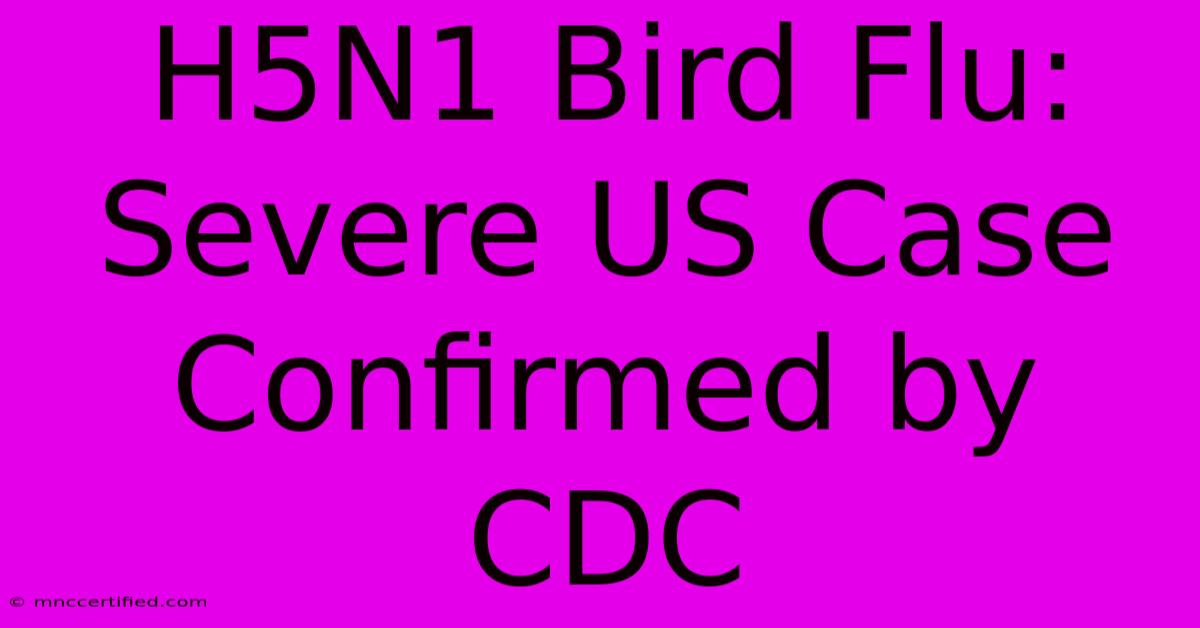H5N1 Bird Flu: Severe US Case Confirmed By CDC

Table of Contents
H5N1 Bird Flu: Severe US Case Confirmed by CDC – What You Need to Know
The Centers for Disease Control and Prevention (CDC) has confirmed a severe case of H5N1 avian influenza (bird flu) in a US resident. This alarming development underscores the ongoing threat of zoonotic diseases and highlights the importance of public health vigilance. While the risk to the general public remains low, this case warrants a closer examination of the virus, its transmission, and the necessary precautions.
Understanding H5N1 Avian Influenza
H5N1 is a highly pathogenic avian influenza virus, primarily affecting birds. While human infections are rare, they can be severe, often leading to severe respiratory illness, even death. Transmission to humans usually occurs through close contact with infected birds, their droppings, or contaminated surfaces. Direct contact with infected poultry is the most significant risk factor.
This recent case serves as a stark reminder that H5N1 remains a potential pandemic threat. While the virus hasn't yet demonstrated sustained human-to-human transmission, the potential for mutation and adaptation remains a concern for global health organizations.
Symptoms of H5N1 Infection
Symptoms of H5N1 infection can vary but often include:
- Fever
- Cough
- Sore throat
- Muscle aches
- Shortness of breath
- Pneumonia
- Diarrhea
- Vomiting
If you experience these symptoms after contact with potentially infected birds or poultry, seek immediate medical attention. Early diagnosis and treatment are crucial for improving outcomes.
The US Case and Public Health Response
The specifics surrounding the US case are still emerging, with the CDC likely releasing more details as the investigation progresses. However, the confirmation itself triggers a heightened response from public health authorities. This includes:
- Enhanced surveillance: Increased monitoring of avian influenza outbreaks in poultry and wild birds.
- Improved communication: Disseminating accurate information to the public and healthcare professionals about the risk and preventive measures.
- Contact tracing: Identifying and monitoring individuals who may have been in close contact with the infected person.
- Strengthening preparedness: Ensuring adequate resources and protocols are in place to manage potential future cases.
Protecting Yourself from H5N1
While the risk to the general public remains low, several precautions can significantly reduce your chances of contracting H5N1:
- Avoid contact with birds: Stay away from wild birds, particularly sick or dead ones. Do not touch bird droppings.
- Practice good hygiene: Wash your hands thoroughly and frequently with soap and water, especially after handling poultry or being outdoors.
- Cook poultry thoroughly: Ensure poultry is cooked to an internal temperature of 165°F (74°C) to kill any potential virus.
- Use appropriate personal protective equipment (PPE): If working with poultry or handling potentially infected birds, wear appropriate PPE, including masks, gloves, and eye protection.
Consult a healthcare professional if you suspect exposure to H5N1. Early intervention is critical for effective treatment and minimizing the severity of the illness.
The Importance of Global Collaboration
The emergence of H5N1 cases highlights the interconnectedness of global health. Effective management requires international collaboration, including sharing of information, coordinated surveillance, and the development of effective vaccines and antiviral treatments. This global effort is crucial in mitigating the risk of future outbreaks and preventing a potential pandemic.
Conclusion: Staying Vigilant Against H5N1
The recent confirmation of a severe H5N1 case in the US underscores the continuing threat of avian influenza. While the immediate risk to the general public is considered low, maintaining awareness, practicing preventative measures, and supporting public health initiatives are paramount. By staying informed and taking appropriate precautions, we can collectively minimize the risk of H5N1 transmission and protect our communities. Further updates from the CDC and other health organizations should be closely monitored for the latest information and guidance.
Keywords: H5N1, Bird Flu, Avian Influenza, CDC, US Case, Pandemic Threat, Symptoms, Prevention, Public Health, Global Health, Zoonotic Disease, Poultry, Wild Birds, PPE, Virus, Transmission, Healthcare, Surveillance, Contact Tracing.

Thank you for visiting our website wich cover about H5N1 Bird Flu: Severe US Case Confirmed By CDC. We hope the information provided has been useful to you. Feel free to contact us if you have any questions or need further assistance. See you next time and dont miss to bookmark.
Featured Posts
-
Busy Bridge Shuts Rush Hour Chaos
Dec 19, 2024
-
Schwarzeneggers Santa New Movie
Dec 19, 2024
-
Grace Dent Replaces Gregg Wallace
Dec 19, 2024
-
Arsenal Vs Crystal Palace Live Score Updates
Dec 19, 2024
-
Arsenal Crystal Palace Live Gabriel Jesus Updates
Dec 19, 2024